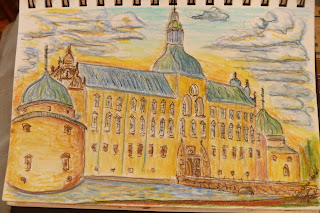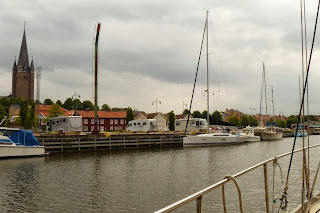Passage Report: 96
In Search of a different Blue: Danish Art Colonies: Skagen, Kerteminde, Faaborg
The artist's "eye," reveals a peoples cultural sense or mood, its context, then and now - creating visual history - of nature or the human condition - seeing beauty, in the obvious or seemingly impossible.
Through art, the traveller, enhances the experience.
Skipper visits local art galleries with each opportunity. Art is a golden thread through the circumnavigation.
Cruising the Baltic, Helsinki (Finland), Tallinn (Estonia), Gothenburg (Sweden), archived superb collections of each nation's art.
An artist learns from others works. Talent stimulates talent - appreciation.
"...its the light...its different in northern Europe..."
"...its a different blue...the clouds more windswept, grey...the shallow sea, short, more sombre..."
Baltic artists visited Paris during the French impressionist period. However, their art was little appreciated. It was of a different mileu. Colour under another sun.
Skipper, first encountered this change in a private gallery in Rendsberg (Kiel Canal, Germany). Exhibited works of North German Realists (inter alia, Lars Moller, Ulf Petermann, Till Warwas), landscaped (plein air) the coastal grey - sky blue, but no impressionist colour: gallery owner "...they sell well..."
Two summer cruises, Skipper sees as they see.
"...a must is Skagen... "
Winds last summer directed Sahula south. This year from Gothenburg, Sahula, impatiently, broad reached to Skagen, a fishing port near the tip of Denmark's Jutland Peninsula. It's where the whimiscal Katteget meets the temptuous, North Sea. As then, today, it is a remote place.
In the 1800's, it was the small fishing community, coast and sea, that attracted artists. They had freedom, to paint, interpret, distant from the controlling city:
"...immense stretches of heath covered with grasses and lichen, high dunes and sandhills, desolate, windswept coasts, dramatic contrast between the forbidding north shore and the gentler coastline...(other side)... and an unhindered view of the sky, where the colours, cloud formations and light are constantly changing..." (Danish Art Colonies, p 13).
In addition, "... the friendly, local, population...where accessible to the figure painters...hostelry... company excellent...food was good and cheap..."
It was a refuge from classical training in the Royal Danish Academy of Fine Arts.
Among others (Viggo Johansen, Kark Madsen, Carl Locher, Laurits Tuxen ...), came Michael Ancher (1848 -1927):
"...you arrived up there and wandered around an untouched and peculiar world. The noise of the world was like a distant whisper..."
Ancher married Anna, a local hoteliers daughter (and accomplished artist) and residents of the village. Her father's hotel and their home became magnets for visiting artists.
Holger Drachmann (painter, writer, poet, who also married and lived locally) looked for "...the great loneliness in the encounter with great nature..."
In 1882, Peder Kroyer (1851-1909) - with wife Marie (a painter, designer), became a Skagen resident. Already "...considered one of his generations greatest artistic talents..." His works and those of Ancher, were to leave an indelible mark on the Skagen "school" and Danish art.
With many visiting artists, a growing fame and successful exhibitions, artists donated works which founded the Skagen Museum, inaugurated in 1928. Today, it includes the original hotel saloon where artists met and the Ancher and Drachman homes, preserved as during the artists lives.
Website: www.skagensmuseum.dk
email: museum@skagensmuseum.dk
It is a superb collection, providing a unique insight into 1880 -1930, Danish art and an 1800's fishing village.
Skipper wandered the historic town and its heath and beach environments. Today, Skagen remains a fishing port, industrialised to service the local and huge atlantic, trawlers. If authenticity is needed, the inevitable odour wafts over parts of the town.
In Skagen, Skipper learnt about other Danish Art Colonies, at Faaborg and Kerteminde. Both are on Fyn Island on Sahula's route south.
Tanya (engine), butted Sahula into a light sea later rough. Skipper motor sailed through the Lille Belt (strait) towards Faaborg, but with headwinds by mid afternoon, Skipper opted to broad reach to the northern most tip of Fyn ("Fyn Hovd") and Korhavn anchorage; towards Kerteminde. Fate was shining.
Korhavn is a painters place. A bay, harbouring flocked wildlife, encirculed by the high, brown, green, cliffs of much of coastal Denmark.
Funen artists painted at Korhavn. Like Skagen, they sought its marine, remoteness and light.
Kerteminde ("minde" - mouth of the Kerte fjord) was a base. Sahula berthed at the town harbour wall. Like Skagen, an 1800's fishing town of cobbled streets between colourful (mainly yellow) houses and spires.
Six artists, three men (Peter Hansen (1858-1928), Johannes Larsen (1867- 1961), Fritz Syberb (1862-1939)) three women (Alhed Larsen (1872-1927), Anna Syberg (1870- 1914), Chrisine Sweane (1876-1961)) comprise the core of the Kerkeminde and Faaborg art colonies.
Unlike Skagen which was essentially a summer colony, Funen artists resided all year.
Johannes Larsen, wealthy millowner, prolific artist, described Kerteminde: "...probably the most beautiful little town in the world, as it lay inside a bay by the mouth of the fjord, turned towards the Belt and the sunrise..."
His family home and gardens have been transformed into the Johannes Larsen Museum. The mill is nearby.
See: www.johanneslarsenmuseet.dk
A strong SW'ly drove Sahula south into the islands of the Store Belt, through the Svenborg Sund (channel).
By late afternoon a headwind required hard working, Tanya to push through the short, steep, white, to Faaborg. The fishing harbour wall provided sanctuary.
Similar to Skagen, Kerteminde; Faaborg is a historic fishing village of cobbled streets and yellow, white houses.
Faaborg Museum initially, housed the art collection of Mads Rasmussen, a wealthy, local, conserve, manufacturer. Encouraged by Funen colony artists, the museum was opened in 1910, in his summer apartment. Architect, Carl Petersen, subsequently, designed a museum building itself, an architectual art work. While representing core Funen colony painters it includes the works of some 50 artists.
See: www.faaborgmuseum.dk
With a north westerly, Sahula reaches fast, for Kiel. An anchorage over night and into the Holtenau Kiel Canal lock to Rendsberg. It is likely to be the final Sahulian sail on the Baltic. Marvellous memories of a Scandinavian summer and friends, flood in.
Every voyage has space places, Rendsberg is ideal for time out. Halfway along the canal, a small historic town with a friendly marina. Skipper restocks, refuels and rests.
Skipper visits the local gallery where earlier visits raised interest in the Northern European Realists and Baltic art. The circle turns.
For the fourth time, Sahula enters the final lock at Brunsbittel to exit the Canal into the Elbe River's racing tide, to Cuxhaven and North Sea.
Early evening; Sahula berths at Cuxhaven marina. Skype links Skipper to daughters and brings news of Australian government changing. Skipper ponders the good and the bad of being so remote from home.
Next Report: Elbe to Holland's Mast Up Route to Amsterdam.
Best
David
7/09/2013
























































































